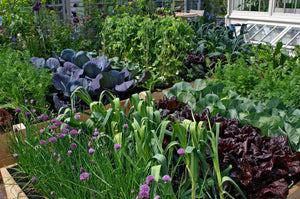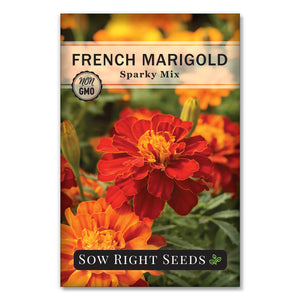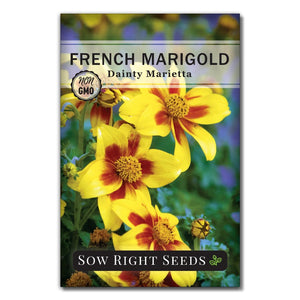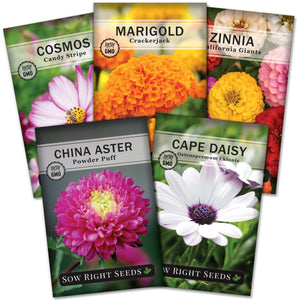Topics
5 Reasons We Love Marigolds and How to Grow Them From Seed
MarigoldsIf you're looking to add some vibrant color to your garden, growing marigolds from seed is a great option. These beautiful flowers are easy to grow and have a variety of benefits for the home gardener. Here are some tips to help you successfully grow marigolds from seed indoors.

Marigolds are one of our “must-grow” flowers. They are an integral part of many cultural celebrations and have benefits for the home vegetable gardener. Marigolds are easy to grow from seed and are sure to become one of your favorite flowers.
Our 5 Favorite Things about Marigolds
1. Super Easy to grow from seed - and save seed
2. Colorful decoration - used in traditional Mexican and Indian celebrations
3. Companion plant - can deter deer, rabbits, cucumber beetle, squash bugs
4. Low maintenance - doesn’t need extra fertilizer or special soil
5. Loves hot weather - and are even drought tolerant
How to Grow Marigolds From Seed
Marigolds are a vibrant flower used extensively in decorating for traditional Indian and Mexican celebrations. And yet, this easygoing flower doesn't demand to be the center of attention, and growing marigolds from seed is surprisingly easy. With a few tips to get you started, you’ll soon be rewarded with colorful blooms all summer.
How to germinate marigold seeds indoors
- Marigold seeds can be directly sown outdoors when the soil temperature is 65ºF.
- To enjoy flowers sooner, seeds can be started indoors 6 weeks before the last spring frost.
- To germinate marigold seeds, start with a clean seed starting medium.
- Plant the seeds 1/4 inch deep.
- Mist your seeds to keep them moist but not wet. A humidity dome will help you to retain this needed moisture. Keep the dome on until the seeds begin to sprout.
- Marigold seeds prefer a soil temperature of 70º to 80º F for optimal seed germination.
- Seeds will germinate in 5 to 10 days.
- Once seeds have sprouted, continue to keep the soil moist by watering from below and allowing the growing medium to soak up the water.
- Once the seedlings are 3 to 4 inches high, it will be time to get them ready for transplanting.
How to transplant marigolds
When all danger of frost is passed, it will be safe to transplant marigold seedlings outdoors. Seedlings should be 3 to 4 inches high and have true leaves.
Choose a location with full sun for transplanting, and don't disturb the roots.
Space African marigolds such as Crackerjack at least 12 inches apart. French marigold varieties can be spaced 6 to 8 inches apart.

How to grow marigolds
Marigolds will grow well in most soils but prefer well-draining soil with a pH between 6 and 7.
These low-maintenance flowers don’t need to be fussed over, and a general-purpose fertilizer can be applied when they are first transplanted. However, after that, they won’t need additional fertilizer. Giving marigolds too much fertilizer will produce more foliage instead of more blooms.
Watering is simple with marigolds. They prefer drier soil and can tolerate periods of drought. However, consistent watering will increase blooms.
Marigolds thrive in full sun and warm weather and are not frost-hardy. You can cover them with a loose layer of lightweight mulch such as straw, or use row covers to protect them from a light frost. However, marigolds will die off when the ground and air stay in freezing temperatures.
Encouraging blooming
Deadheading marigolds will encourage more blooms and stop them from going to seed. Also, if you want to promote denser growth, pinch off the tops, and more side branches will grow.
Marigold Varieties
Marigolds are of the Tagetes genus in the Asteraceae family. There is often confusion with Calendula as it is sometimes called “pot marigold.” However, Calendula is its own genus in the Asteraceae family and is not of the Tagetes genus. Calendula is grown and used for medicinal purposes.
The patula and erecta varieties of the Tagetes genus are used in India, Thailand, and Mexico. Although both varieties originated in South America, Tagetes patula is considered the French variety, and Tagetes erecta is the African variety.
Sparky Mix Marigold
Add an attractive spark of color to your containers, beds, and borders with Sparky Mix marigold (Tagetes patula).
These long-lasting double blooms have wavy orange, yellow, crimson, gold, or bicolor petals. The Sparky Mix plants will grow up to 14" tall.
A beautiful addition to a flower garden, they are also an ideal companion plant to attract pollinators and repel nematodes.
Crackerjack Marigold
Crackerjack marigolds grow into large 3 to 4-foot tall bushy plants that produce tons of bright yellow or orange flowers. This African Marigold (Tagetes erecta) grows quickly from seed and blooms continuously from summer through fall.
Crackerjack marigolds will be a beneficial companion plant in your vegetable garden to repel pests.
Dainty Marietta Marigold
If you’re looking for a shorter marigold that has a unique color, Dainty Marietta is a delightful dwarf French marigold (Tagetes patula). The petite flowers have bright yellow petals with a dash of maroon towards the center. These easy-growing marigolds will reach a height of 10 inches.
Companion Planting with Marigolds
Marigolds have often been used as companion plants. While many of their benefits are anecdotal, results from a University of Iowa companion planting study showed positive results. The study found that when marigold plants were intercropped with zucchini, the zucchini had less damage from cucumber beetles and squash bugs.
The smell of marigolds also seems to deter deer and rabbits. These reasons make marigolds a popular flower to plant in vegetable gardens.
Growing marigolds in pots
Marigolds can easily be grown in pots. Just be aware of which variety you are planting and choose containers that will be the appropriate size. The Crackerjack variety can grow to 4 feet tall, so you will want pots that won’t fall over when the marigolds reach their full growth.
Letting marigold go to seed
Marigold seeds are easy to collect for planting next season. Several weeks before the first fall frost, stop deadheading the flowers and allow them to finish their growth process. The flowers will die back, and the seeds will develop. When the marigold seeds fall off, they can be gathered and stored or left in the soil to grow independently.
We love the easygoing nature of marigolds. They are bright and beautiful and yet don’t require a lot of attention. You’ll love growing marigolds in your flower beds and vegetable garden.









Leave a comment